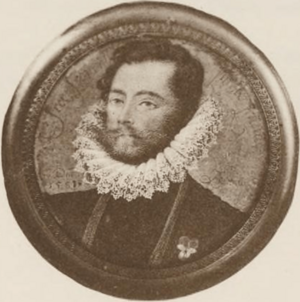George Carey (c. 1541 – 1616) facts for kids
Sir George Carey (also spelled Cary) was an important English official who lived from about 1541 to 1616. He came from Cockington in Devon, England. He held many important roles, including being a Justice of the Peace and a Deputy Lieutenant. His most significant position was serving as the Lord Deputy of Ireland from May 1603 to February 1604.
It's important not to confuse him with his distant relative, Sir George Carew, who also worked in Ireland around the same time.
Contents
Sir George Carey's Family Roots
George Carey was the oldest son of Thomas Cary, who passed away in 1567. Thomas Cary was the lord of the manor of Cockington. George's mother was Mary Southcott. His family had a long history in Devon. His grandfather, Robert Cary, was the lord of the manor of Clovelly.
Sir George Carey's Public Service
Sir George Carey began his career by studying law at the Inner Temple in 1558. By 1572, he became a captain in the Devon local army. Around 1579, he was made a Justice of the Peace, helping to keep law and order. In 1587, he became a Deputy Lieutenant, assisting the main county official.
He was elected as a Member of Parliament (MP) for Dartmouth in 1586. Later, in 1588, he represented the entire county of Devon in Parliament.
Sir George also served as the treasurer for the army during the campaign of Robert Devereux, 2nd Earl of Essex in Ireland in 1599. When Essex left Ireland, Sir George was appointed as a Lord Justice in September 1599. He held this position again in 1603 after Charles Blount, 8th Baron Mountjoy departed.
In 1601, Sir George Carey was involved in changing the Irish money system, which led to a less valuable currency. He was later accused of making money unfairly from this process. However, after a long legal case, nothing was ever proven against him. This might be why his portrait has the words "free from all filthy fraud" written on it.
Sir George Carey's Marriages and Children
Sir George Carey married twice.
His first marriage was around 1561 to Wilmota Giffard (1540/1–1581). She was the only daughter and heir of John Giffard. Wilmota had been married before, but her first marriage ended in divorce. Sir George and Wilmota had two sons and three daughters.
- Thomas Cary: He died without having any children.
- Sir George Cary: He was a respected military commander but was killed in the Irish Wars. He also died without having any children, before his father.
- Jana Cary: She died without having any children.
- Anna Cary: She was the first wife of Sir Richard Edgcumbe. She also died without having any children.
Sir George's second marriage was to Lettice Rich. She was the daughter of Robert Rich, 1st Earl of Warwick. They did not have any children together. After Sir George's death, Lettice remarried Sir Arthur Lake.
Who Inherited Sir George Carey's Estate?
Since all of Sir George Carey's own children died without having any children themselves, his estate at Cockington was passed down to his nephew, George Cary. This nephew was the fifth son of Sir George's younger brother, John Cary. This George Cary was married to Elizabeth Seymour, whose family was connected to King Edward VI.
Sources
- Pole, Sir William (died 1635), Collections Towards a Description of the County of Devon, Sir John-William de la Pole (ed.), London, 1791.
- Vivian, Lt.Col. J.L., (Ed.) The Visitations of the County of Devon: Comprising the Heralds' Visitations of 1531, 1564 & 1620. Exeter, 1895.
| Political offices | ||
|---|---|---|
| Preceded by Lord Mountjoy |
Lord Deputy of Ireland 1603–1604 |
Succeeded by Sir Arthur Chichester |



